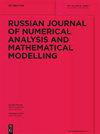The suite of Taylor–Galerkin class schemes for ice transport on sphere implemented by the INMOST package
IF 0.6
4区 数学
Q4 MATHEMATICS, APPLIED
Russian Journal of Numerical Analysis and Mathematical Modelling
Pub Date : 2021-08-01
DOI:10.1515/rnam-2021-0019
引用次数: 1
Abstract
Abstract Realizations of the numerical solution of the scalar transport equation on the sphere, written in divergent form, are presented. Various temporal discretizations are considered: the one-step Taylor–Galerkin method (TG2), the two-step Taylor–Galerkin method of the second (TTG2), third (TTG3), and fourth (TTG4) orders. The standard Finite-Element Galerkin method with linear basis functions on a triangle is applied as spatial discretization. The flux correction technique (FCT) is implemented. Test runs are carried out with different initial profiles: a function from C∞ (Gaussian profile) and a discontinuous function (slotted cylinder). The profiles are advected by reversible, nondivergent velocity fields, therefore the initial distribution coincides with the final one. The case of a divergent velocity field is also considered to test the conservation and positivity properties of the schemes. It is demonstrated that TG2, TTG3, and TTG4 schemes with FCT applied give the best result for small Courant numbers, and TTG2, TTG4 are preferable in case of large Courant number. However, TTG2+FCT scheme has the worst stability. The use of FCT increases the integral errors, but ensures that the solution is positive with high accuracy. The implemented schemes are included in the dynamic core of a new sea ice model developed using the INMOST package. The acceleration of the parallel program and solution convergence with spatial resolution are demonstrated.由INMOST包实现的球上冰传输的Taylor-Galerkin类方案集
摘要给出了用发散形式写成的球上标量输运方程数值解的实现。考虑了各种时间离散化:一阶Taylor–Galerkin方法(TG2)、二阶(TTG2)、三阶(TTG3)和四阶(TTG4)的两阶Taylor–Gallerkin方法。将三角形上具有线性基函数的标准有限元伽辽金方法应用于空间离散化。实现了通量校正技术(FCT)。使用不同的初始轮廓进行了试运行:一个来自C∞的函数(高斯轮廓)和一个不连续函数(开槽圆柱体)。剖面被可逆的非分散速度场平推,因此初始分布与最终分布一致。还考虑了发散速度场的情况来检验方案的守恒性和正性。结果表明,应用FCT的TG2、TTG3和TTG4方案对于小Courant数给出了最好的结果,而对于大Courant数,TTG2、TTG4是优选的。然而,TTG2+FCT方案的稳定性最差。FCT的使用增加了积分误差,但确保了高精度的正解。所实施的方案包含在使用INMOST软件包开发的新海冰模型的动态核心中。证明了并行程序的加速性和解在空间分辨率下的收敛性。
本文章由计算机程序翻译,如有差异,请以英文原文为准。
求助全文
约1分钟内获得全文
求助全文
来源期刊
CiteScore
1.40
自引率
16.70%
发文量
31
审稿时长
>12 weeks
期刊介绍:
The Russian Journal of Numerical Analysis and Mathematical Modelling, published bimonthly, provides English translations of selected new original Russian papers on the theoretical aspects of numerical analysis and the application of mathematical methods to simulation and modelling. The editorial board, consisting of the most prominent Russian scientists in numerical analysis and mathematical modelling, selects papers on the basis of their high scientific standard, innovative approach and topical interest.
Topics:
-numerical analysis-
numerical linear algebra-
finite element methods for PDEs-
iterative methods-
Monte-Carlo methods-
mathematical modelling and numerical simulation in geophysical hydrodynamics, immunology and medicine, fluid mechanics and electrodynamics, geosciences.

 求助内容:
求助内容: 应助结果提醒方式:
应助结果提醒方式:


